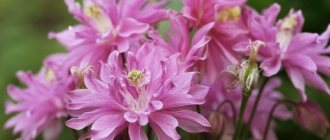Author: Elena N. https://floristics.info/ru/index.php?option=com_contact&view=contact&id=19 Category: Garden plants Published: November 09, 2017Last edits: November 04, 2020
- Growing conditions
- Tamarix tetrandra
Tamarix (lat. Tamarix), or tamarisk, or comb is a type genus of small trees and shrubs of the Tamarisk family, numbering more than 75 species. These plants are also known under the names “God’s tree”, “bisernik”, “comb”, “zhidovilnik”, “Astrakhan lilac” and “jengil”. The scientific name of the plant comes from the toponym of the Tama-riz River in the Pyrenees - now called Timbra. Representatives of the genus are found in semi-deserts and deserts, on salt marshes and solonetzes, as well as in the sand dunes of Africa, Asia and southern Europe. For example, 15 species of tamarix grow in the tugai forests of Central Asia; in the Caucasus, plants rise to a height of 600 m, and in the mountains of Central Asia - up to 2000 m above sea level. In culture, the tamarix shrub is grown as a sand-fixing and ornamental plant.
Planting and caring for tamarix
- Flowering: depending on the species, but usually in April-May.
- Planting: best in early spring, but possible during leaf fall.
- Lighting: bright light or partial shade.
- Soil: any well-drained soil.
- Watering: the first 2-3 weeks after planting - abundant and frequent. Mature plants require moisture only during periods of prolonged drought.
- Feeding: in early spring - with a solution of organic fertilizer, and in summer, foliar feeding is carried out with potassium-phosphorus fertilizer and solutions of microelements.
- Pruning: sanitary, thinning and rejuvenating - in early spring, before the start of sap flow, or after flowering.
- Reproduction: seeds and cuttings.
- Pests: practically not affected.
- Diseases: resistant, but may suffer from root rot due to excessive moisture.
Read more about growing tamarisk below.
Reproduction of Tamarix
Cactus fruit: description of species and their benefits and harms
There are several ways to propagate a plant - seed and through cuttings. The first is used mainly by breeders, but for ordinary gardeners this process is labor-intensive and time-consuming, which does not provide any guarantees.
Appearance of healthy Tamarix seeds
It is recommended to propagate the shrub by cuttings in the spring. For this, planting material is prepared - semi-lignified cuttings up to 10 cm long and at least 10 mm thick. To avoid the development of diseases, the lower cut is carefully treated with a disinfecting solution, and then placed in a growth stimulator. The next stage is to plant the cuttings in containers filled with substrate at an angle. The soil should contain garden soil and sand.
Note! To create a greenhouse effect, the container is covered with a transparent dome on top.
Now we just have to wait for the cuttings to take root. As soon as this happens, leaves will begin to form on the young plant. The right time for planting in open ground is May. And it is important not to forget about covering the tamarix for the winter.
There is another way to propagate an ornamental plant. The cuttings are placed in a container with water. As soon as the roots appear, the plant is planted in a pot and covered with a glass jar or a cut plastic bottle.
Propagation of Tamarix by cuttings
Botanical description
Tamarix are graceful deciduous or evergreen shrubs. Often among them there are bush-like trees with a height of 1.5 to 12 m with a trunk thickness of up to 50 cm. The crown of tamarix is formed by twig-like shoots, densely dotted with scale-like alternate miniature leaves of a bluish-green, emerald or dark green hue. Small pink or white tamarisk flowers form large racemes or panicles. Before the flowers open, the bud-covered plant looks as if it has been studded with beads. During the flowering period, tamarix attracts bees because it is an excellent honey plant. The fruit of Tamarix is a pentagonal-pyramidal multi-seeded capsule with small seeds.
The Tamarix plant is distinguished by drought resistance and extraordinary vitality. It adapts perfectly to the gas pollution of large cities, and planting and caring for tamarisk will not cause trouble even for a lazy gardener.
Planting tamarix in open ground
When to plant
Tamarix seedlings are planted in early spring or during leaf fall, but spring planting is preferable. Tamarisk needs well-drained soil, but the plant does not have any special requirements for its composition: it grows even in heavy clay, provided that peat and humus are added to the hole during planting. Tamarisk is also undemanding when it comes to lighting, but grows better in well-lit areas.
- Description of popular varieties of floribunda roses
When choosing a place for tamarisk, think carefully about everything, since its thin, long roots do not tolerate transplantation very well.
How to plant
A pit for tamarisk is dug 60x60x60 cm in size. A layer of drainage material (expanded clay, broken brick, pebbles or crushed stone) 20 cm thick is placed on its bottom, a layer of wood ash with humus is placed on top of the drainage, and then the hole is filled 2/3 with a fertile mixture earth, sand and peat in a ratio of 2:1:1.
The shoots of the seedling are cut off before planting, leaving no more than 3-5 cm from each, after which the seedling is lowered into the planting hole, its roots are straightened and the remaining space is filled with a mixture of the composition described above. The surface around the seedling is compacted and watered abundantly. After planting and watering, the neck should be at soil level.
Planting and caring for Tamarix in open ground
What you need to know to properly grow the elegant Tamarisk or Comb shrub in the garden.
Where is the best place to plant Tamarix?
If possible, choose a well-lit area in the garden for the plant. A partially shaded place is possible, but with a duration of sun exposure of up to 4 hours. The more sunlight the plant receives, the more magnificent the flowering will be. The south side of the site is welcome.
What soil does Tamarix prefer?
These trees grow well in a variety of soil types (even tolerate alkaline or salty soil). However, heavy soils should be treated with plenty of sand to keep them permeable. The soil can be either acidic or calcareous. Even nutrient-poor soils do not pose a problem for the Grebenshchik.
You might be interested
The best perennial bush flowers for the garden: features and selection rules
We use decorative coniferous shrubs in garden landscape design
The best shrubs for hedges
How to plant Tamarix correctly
Tamarix seedlings are best planted in spring or autumn. They will look great as single plants. But when landing you need to take into account some nuances:
- These shrubs have deep roots, so care should be taken to loosen the planting site as deeply as possible. This way the young plant can develop well.
- You need to plan the distance to neighboring plants. It should be half the expected growth width. You may also want to inquire about mature plant size information when purchasing Tamarisk. When planting a group of shrubs in a row, it is worth planting them at a distance of 1.2 - 1.5 from each other.
Once all conditions are met, you can begin planting. To do this, dig a hole twice the size of the seedling's root ball. Before planting, place the root ball in water to soak it in moisture. When planting, try not to injure the roots of the Comb - it does not tolerate this. Place the seedling in the hole and fill the planting hole with permeable soil and water thoroughly.
In the following weeks and months, you need to regularly water the young bush. Only when the plant grows, the frequency of watering should be reduced.
Caring for tamarisk in the garden
Growing conditions
For the first 2-3 weeks after planting, the tamarisk seedling should be protected from the sun and watered regularly. When leaves appear on the plant, the shading is removed and watering is done less frequently. To retain moisture in the soil for as long as possible, the plant’s trunk circle needs to be mulched with some organic material. Adult tamarix are watered only during prolonged drought, but if it rains in the summer, do not moisten the soil around the plant at all. After watering or rain, remove the weeds that appear in the tree trunk circle and lightly loosen the soil.
Tamarix is fed in early spring, at the beginning of the growing season, with organic matter, and in the summer it is treated on the leaves with potassium and phosphorus fertilizers.
The plant's winter hardiness allows it to be grown in areas with a fairly cool climate, so tamarix has long been not uncommon in the Moscow region or the Urals. However, if weather forecasters say that in winter the temperature can drop to -28 ºC, even the most cold-resistant plants need to be covered: the tamarisk trunk is wrapped in polymer film or thick fabric, and the root zone is insulated with spruce branches or a thick layer of sawdust.
- 5 tips on how to speed up the ripening of tomatoes on the bush
Trimming
Tamarisk care includes crown formation. The plant tolerates pruning easily. It is best to carry it out in early spring, before the buds begin to swell. Old tamarisk branches with short growths are cut into a ring, but within a month they will give rise to young shoots, and the crown of the bush will again turn into a lush hat. Rejuvenating pruning of tamarisk is done on a strong branch located as close as possible to the base of the bush. Make sure that the growth of tamarisk shoots does not weaken, as this will be followed by a reduction in the number and length of the inflorescences. When the growing season begins and the degree of frosting of branches and shoots becomes visible, prune them back to healthy wood.
You can also prune after the tamarix has finished blooming: to give the crown a well-groomed, neat appearance, remove all wilted inflorescences and very elongated shoots. By pruning, try to give the bush greater stability so that you do not have to tie the branches to supports.
The crown of tamarisk thickens easily, so it must be thinned out regularly, removing some of the branches.
Pests and diseases
Pests hardly bother tamarisk. There have been cases when they moved onto the bush from a neighboring plant, but in order to get rid of them, one treatment of the tamarisk with an insecticide solution is enough.
The situation is worse with fungal diseases: they easily infect the plant during the rainy season. Affected shoots and branches must be ruthlessly cut off, and the plant and the soil around it must be treated with a fungicide solution.
Reproduction of tamarix in the garden
Tamarisk is propagated by cuttings and seeds, but experts recommend not wasting time on experiments with generative propagation, since the vegetative method gives more reliable and faster results.
Cuttings are carried out in early spring: semi-lignified cuttings 7-10 cm long and 1 cm thick are cut from the shoots, their lower cut is dipped in a root-forming solution and planted at an angle in a box with a light substrate (garden soil and sand in equal parts). Place a transparent dome on top of the box or cover each cutting with a glass jar. You will know that rooting was successful when young leaves appear on the cuttings. Rooted cuttings are planted in open ground in May, but they must be covered for the winter. Next spring, the seedlings that have overwintered in the garden and become stronger can be planted in a permanent place.
- Goldenrod: properties, cultivation, types
To be safe, you can first hold the cuttings in water, and as soon as they form roots, the cuttings are planted in the ground and covered with jars.
If you nevertheless decide to grow tamarix from seeds, keep in mind that the seed material of this plant very quickly loses its viability, and in the middle zone the seeds rarely ripen at all. Sowing is carried out without preliminary stratification along the surface of the substrate. There is no need to plant the seeds. The container with the crops is placed on a tray with water. When the seedlings grow up and become stronger, they are planted in a school for growing. They must be covered for the winter. Tamarisk seedlings are transplanted to a permanent place after a year or two.
Using Tamarix in garden landscape design
Tamarisk can be shaped into a large bush or small tree. Either way, this versatile plant will add beauty to your garden without asking for much in return. Harsh winds are also no problem for these hardy plants, which is why their choice as a windbreak is often used by many gardeners.
The comb can also be planted as a single plant - a spreading bush that blooms in spring or summer. Tamarisk can be planted in groups, using it as a backdrop to a flower arrangement or to cover unsightly structures or fences. Its neighbors can be a variety of shrubs: Jasmine, Almond, etc. It goes well with Lilac, Barberry, and perennial herbs.
Types and varieties
Of the more than 70 species of tamarisk, the most winter-hardy plants are most often grown in cultivation.
Tamarix tetrandra
grows in Crimea, Greece, Asia Minor and the southeast of European Russia. This is a large shrub from 5 to 10 m high with brownish-red arched branches. The leaves on the branches are emerald green, lanceolate or ovate-lanceolate, narrowed towards the base, with a beak-shaped pointed apex. Flowers from white to light pink are collected on side shoots in racemes. Flowering begins in April-May. The species is drought-resistant and durable (lives up to 75 years).
Tamarix laxa
grows wild in Mongolia, Northwestern China, Afghanistan, Northern Iran and the lower reaches of the Volga. It can be a large and branchy shrub or tree up to 5 m high with spreading bare branches, green or gray. The leaves of this species are erect, ovate or oval-rhombic, pointed towards the apex and narrowed towards the base. Pink flowers are collected in dense brushes, which in turn form apical panicles. Flowering of this species lasts about 2 months. It is frost-resistant, drought-resistant, unpretentious to the composition of the soil and tolerates salinity well.
Tamarix gracilis
grows naturally in Kazakhstan, China, Siberia, western Mongolia, Ukraine and the south of European Russia. The shrub reaches a height of 4 m, it has thick, tapering branches covered with brownish-chestnut or gray-green bark and light fawn spots of cork along the shoots and in the axils of the leaves. On green shoots, pointed leaves are arranged imbricately; on one-year-old branches the leaves are larger, fawn, lanceolate. Spring simple clusters of bright pink flowers reach a length of 5 cm. Summer flower clusters, collected in large paniculate inflorescences, are somewhat longer - 7 cm. Tamarix graceful is a beautifully flowering and frost-resistant shrub that is of interest to landscape designers.
Branched tamarix (Tamarix ramosissima)
or five-stamen tamarix (Tamarix pentandra) grows on pebble shallows, river banks, and on terraces of river valleys in China, Iran, the Balkans, Mongolia, Central Asia, Moldova and Ukraine. It is an upright growing shrub up to 2 m high with thin greenish or bluish branches and annual reddish shoots. Its leaves are narrow, awl-shaped, with curved ends. Pink flowers are collected in dense complex racemes up to 5 cm long. Flowering begins in June and ends in September. The species is distinguished by its unpretentiousness to the composition of the soil, easily adapts to urban conditions, quickly recovers after freezing, but requires shelter for the winter. The most popular varieties are:
- Pink Cascade is a plant characterized by abundant and lush flowering;
- Rubra is a variety with purple-red flowers;
- Summer Glow is a shrub with bright crimson inflorescences.
Types and varieties of tamarix with photos and names
There are more than 70 species of tamarix in nature. However, those that have high frost resistance are most often cultivated.
Tamarix tetrandra
In nature, this species is found in Greece, Crimea, Asia Minor, as well as in the southeast of the European part of Russia. This shrub is relatively large, reaching a height of 5–10 meters. The arched branches are colored red-brown. The green-emerald leaf plates have an ovate-lanceolate or lanceolate shape, they taper towards the base, and at their top there is a beak-shaped point. On the side shoots there are racemose inflorescences consisting of flowers painted in various shades from pale pink to white. The plant blooms in April or May. This shrub is drought-resistant and durable (can live for about 75 years).
Tamarix laxa
Under natural conditions, such a plant is found in Northwestern China, Northern Iran, Mongolia, Afghanistan and the lower reaches of the Volga. This species is represented by a large branched shrub or small tree, its height is about 5 meters. The bare spreading branches are colored gray or green. Straight apart leaf plates of oval-rhombic or ovoid shape taper towards the base and become pointed towards the apex. The apical panicles are formed by lush racemose inflorescences consisting of pink flowers. This plant blooms for about 8 weeks. This species is distinguished by drought and frost resistance, it is not picky about the soil and tolerates salinity well.
Tamarix gracilis
Under natural conditions, such tamarisk is found in China, Ukraine, Kazakhstan, Siberia, western Mongolia and the south of the European part of Russia. The height of the bush does not exceed 4 meters. On the surface of the tapering thick branches there are pale fawn spots of cork in the leaf axils and along the shoot. The color of the bark is greenish-gray or chestnut-brown. The pointed leaf plates on green shoots are arranged in a tiled pattern. On one-year-old branches, larger leaf blades grow, and they are lanceolate in shape and fawn in color. The simple spring racemose inflorescences are about 50 mm long and consist of deep pink flowers. Summer flower racemes are part of large paniculate inflorescences, and they reach a length of 70 mm. This species is frost-resistant and beautifully flowering; it is often used by landscape designers.
Branched tamarix (Tamarix ramosissima), or five-stamen tamarix (Tamarix pentandra)
In the wild, such a plant can be found in Iran, Mongolia, Moldova, China, Central Asia, Ukraine and the Balkans. It prefers to grow on river banks, pebble banks and on terraces of river valleys. The height of such an upright shrub is about 2 meters. Thin branches are painted light gray or pale green, and annual shoots are pale red. Narrow, awl-shaped leaf blades have curved tips. Dense complex racemose inflorescences reach 50 mm in length and consist of pink flowers. Flowering occurs in June–September. This shrub is not demanding on the composition of the soil, quickly adapts to city conditions, and is easily restored after freezing, but it must be covered for the winter. Popular varieties:
- Pink Cascade . This variety blooms very luxuriantly.
- Rubra . The color of the flowers is red-violet.
- Summer Glow . The color of the flowers is deep crimson.
Tamarix in landscape design
Tamarisks are used in landscaping for group compositions, trimmed hedges and as tapeworms, for example, as a blooming “fountain” in the center of a green lawn. Low bushes and tamarisk trees go well with conifers - junipers, thujas, dwarf spruces. Tamarix harmonizes with barberry, lilac and jasmine.
Some evergreen species of the genus can even be grown indoors. Tamarisks are used in forest plantations, on saline soils, in semi-deserts and deserts, and to stabilize sliding banks and shifting sands.
Tamarisk in landscape design
Tamarisk is used in landscaping for group compositions and trimmed hedges. This plant is also used as a tapeworm, for example, as a flowering “fountain” in the center of a green lawn. It is recommended to combine not very tall trees and shrubs of this kind with coniferous plants, namely: thuja, juniper and dwarf spruce. This plant also harmonizes with lilac, barberry and jasmine.
Certain evergreen species of tamarisk are cultivated at home. Tamarix is also grown on saline soils, in forest plantations, in deserts and semi-deserts, and is also used to stabilize shifting sands and sliding banks.
Tamarix











